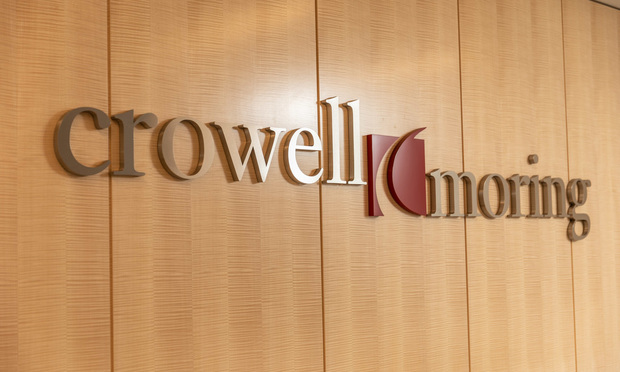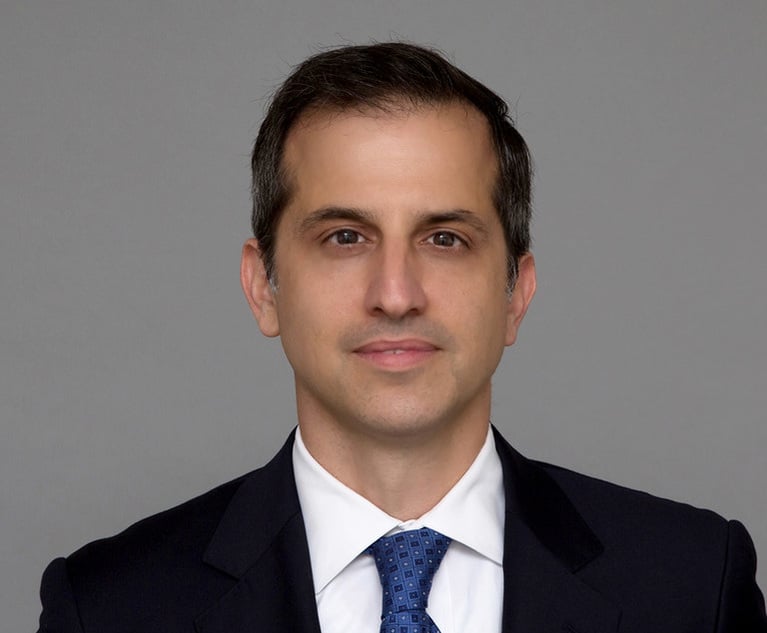Daily Dicta: Think Your Client Alerts Are Good? Check Out Crowell's Litigation Forecast
Crowell & Moring on Wednesday released its eighth annual Litigation Forecast--a forward look by firm lawyers at potential challenges corporate counsel may encounter in the coming year.
January 22, 2020 at 01:27 AM
6 minute read
 Crowell Moring. (Photo: Jason Doiy/ALM)
Crowell Moring. (Photo: Jason Doiy/ALM)
As someone who writes about litigation and Big Law, I'm an avid consumer of law firm publications.
One of the best, in my opinion, is Crowell & Moring's Litigation Forecast—a forward look by firm lawyers at potential lawsuits corporate counsel may encounter in the coming year across a wide swath of practice areas.
The firm on Wednesday released its eighth annual forecast, diving into litigation based on AI-enabled- and other smart products. The forecast also looks at employment suits challenging non-compete agreements; new avenues for false advertising suits, disability litigation, venues for patent litigation, legal data analytics and more—all with an overarching theme of regulation by litigation.
 The forecast is formatted to look like a snazzy, 36-page magazine. The firm sends out several thousand hard copies to clients and in-house counsel, and gets another 10,000-plus reads online.
The forecast is formatted to look like a snazzy, 36-page magazine. The firm sends out several thousand hard copies to clients and in-house counsel, and gets another 10,000-plus reads online.
Mark Klapow, co-chair of the firm's litigation group and editor of the forecast, said the publication is designed to be "easily-digestible"—something that can be read cover-to-cover in an hour or less, without the stuffy, retrospective feel of a law review article or case digest.
"We get a lot of feedback from clients and lawyers at other firms," Klapow said—a reception that makes the (considerable) work involved worthwhile. Indeed, putting together the publication, which showcases more than a dozen firm partners, begins about nine months before publication.
This year's cover story, "A Tangled Web" focuses on litigation involving the internet of things and AI.
Here's an excerpt:
"According to the World Economic Forum, there will be more than 20 billion devices connected to the Internet of Things by the end of this year, from smart watches to doorbells, refrigerators, security cameras, and voice- powered assistants. The first wave of product liability attacks against IoT devices foundered on a basic legal problem: the products had not failed. Plaintiffs' lawyers tried to create causes of action based on the potential for failure, but those claims were dismissed for lack of standing.
"Now, however, as more IoT devices are in service and performing critical life- and safety-protecting applications, product failures have begun. And as breaks occur, a new wave of tort litigation threatens to derail a company's digital business innovations."
Crowell partner Cheryl Falvey, a former general counsel of the Consumer Product Safety Commission, points out that when failures occur in digitally enabled products–which often involve components from many suppliers and partners–it's difficult to figure out who is to blame.
"We are going to see even more finger-pointing in court about who's liable, as different suppliers dispute whether they are responsible for the product's failure," she says in the article.
Consumer warnings and disclaimers won't necessarily be enough to dodge liability. "There's a general feeling among tech start-ups that you can just disclaim or warn away that lack of performance as a software 'glitch,'" Falvey said. "But when that performance glitch relates to safety, a warning may not be enough. The law is very clear that if you can design away a product defect, you can't just stick a warning on the product and hope things don't go wrong."
She also anticipates fights over software.
"You might have several software developers contributing to the functionality of the product," she said. To get to the root of the problem, companies may need to carefully scrutinize each piece of software. "But you might not have the right to look into that proprietary software. So we think there will be litigation fights over discovery asking for software source code as companies try to figure out what went wrong."
Another interesting article features labor & employment partner Tom Gies, who looks at non-compete agreements and other post-employment restrictions.
"As companies become more aggressive in trying to enforce post- employment restrictive covenants, 'there's been a fair amount of pushback by courts that are skeptical of attempts to enforce them and less inclined to grant temporary restraining orders against former employees, particularly medium- and lower-level employees,' says Gies.
"Some courts appear reluctant to enforce agreements that could essentially limit a person's right to make a living—especially where the mid- or low-level employee did not have much bargaining power when hired. And in a time when company-employee loyalty has all but disappeared, some courts may view switching jobs as a 'new normal,' as employees seek to advance their careers through lateral moves."
I was also intrigued by a piece that examines false advertising lawsuits.
Traditionally, companies upset with their competitors' ads turned to a voluntary forum—The National Advertising Division, part of the Council of Better Business Bureaus—to sort out their complaints.
But in the past year, Crowell's Holly Melton says there's been an uptick in Lanham Act false advertising litigation. "Many advertisers have elected to pursue claims in federal court, even when the advertising at issue is not necessarily expressly false but only impliedly so, which carries the additional evidentiary burden of proving consumer deception," she reports.
Why the change? "Today what I more often hear from advertisers is that they view the NAD process as less predictable, and we are seeing more decisions with a clear winner and a clear loser," she said.
"It used to be that if your advertising was literally truthful but subject to being construed as misleading, companies could rest easy that the most likely avenue for a challenge would come through NAD. Companies were less likely to be challenged in court because of the higher evidentiary burden relating to impliedly false advertising claims," she continued. "I don't think companies can rest so easy these days. They should be aware of the increased appetite for filing false advertising cases in court."
Read the full Litigation Forecast here.
This content has been archived. It is available through our partners, LexisNexis® and Bloomberg Law.
To view this content, please continue to their sites.
Not a Lexis Subscriber?
Subscribe Now
Not a Bloomberg Law Subscriber?
Subscribe Now
NOT FOR REPRINT
© 2025 ALM Global, LLC, All Rights Reserved. Request academic re-use from www.copyright.com. All other uses, submit a request to [email protected]. For more information visit Asset & Logo Licensing.
You Might Like
View All
Firms Come Out of the Gate With High-Profile Litigation Hires in 2025

2024 Marked Growth On Top of Growth for Law Firm Litigation Practices. Is a Cooldown in the Offing for 2025?

Big Company Insiders See Technology-Related Disputes Teed Up for 2025

Litigation Leaders: Jason Leckerman of Ballard Spahr on Growing the Department by a Third Via Merger with Lane Powell
Trending Stories
- 1Rejuvenation of a Sharp Employer Non-Compete Tool: Delaware Supreme Court Reinvigorates the Employee Choice Doctrine
- 2Mastering Litigation in New York’s Commercial Division Part V, Leave It to the Experts: Expert Discovery in the New York Commercial Division
- 3GOP-Led SEC Tightens Control Over Enforcement Investigations, Lawyers Say
- 4Transgender Care Fight Targets More Adults as Georgia, Other States Weigh Laws
- 5Roundup Special Master's Report Recommends Lead Counsel Get $0 in Common Benefit Fees
Who Got The Work
J. Brugh Lower of Gibbons has entered an appearance for industrial equipment supplier Devco Corporation in a pending trademark infringement lawsuit. The suit, accusing the defendant of selling knock-off Graco products, was filed Dec. 18 in New Jersey District Court by Rivkin Radler on behalf of Graco Inc. and Graco Minnesota. The case, assigned to U.S. District Judge Zahid N. Quraishi, is 3:24-cv-11294, Graco Inc. et al v. Devco Corporation.
Who Got The Work
Rebecca Maller-Stein and Kent A. Yalowitz of Arnold & Porter Kaye Scholer have entered their appearances for Hanaco Venture Capital and its executives, Lior Prosor and David Frankel, in a pending securities lawsuit. The action, filed on Dec. 24 in New York Southern District Court by Zell, Aron & Co. on behalf of Goldeneye Advisors, accuses the defendants of negligently and fraudulently managing the plaintiff's $1 million investment. The case, assigned to U.S. District Judge Vernon S. Broderick, is 1:24-cv-09918, Goldeneye Advisors, LLC v. Hanaco Venture Capital, Ltd. et al.
Who Got The Work
Attorneys from A&O Shearman has stepped in as defense counsel for Toronto-Dominion Bank and other defendants in a pending securities class action. The suit, filed Dec. 11 in New York Southern District Court by Bleichmar Fonti & Auld, accuses the defendants of concealing the bank's 'pervasive' deficiencies in regards to its compliance with the Bank Secrecy Act and the quality of its anti-money laundering controls. The case, assigned to U.S. District Judge Arun Subramanian, is 1:24-cv-09445, Gonzalez v. The Toronto-Dominion Bank et al.
Who Got The Work
Crown Castle International, a Pennsylvania company providing shared communications infrastructure, has turned to Luke D. Wolf of Gordon Rees Scully Mansukhani to fend off a pending breach-of-contract lawsuit. The court action, filed Nov. 25 in Michigan Eastern District Court by Hooper Hathaway PC on behalf of The Town Residences LLC, accuses Crown Castle of failing to transfer approximately $30,000 in utility payments from T-Mobile in breach of a roof-top lease and assignment agreement. The case, assigned to U.S. District Judge Susan K. Declercq, is 2:24-cv-13131, The Town Residences LLC v. T-Mobile US, Inc. et al.
Who Got The Work
Wilfred P. Coronato and Daniel M. Schwartz of McCarter & English have stepped in as defense counsel to Electrolux Home Products Inc. in a pending product liability lawsuit. The court action, filed Nov. 26 in New York Eastern District Court by Poulos Lopiccolo PC and Nagel Rice LLP on behalf of David Stern, alleges that the defendant's refrigerators’ drawers and shelving repeatedly break and fall apart within months after purchase. The case, assigned to U.S. District Judge Joan M. Azrack, is 2:24-cv-08204, Stern v. Electrolux Home Products, Inc.
Featured Firms
Law Offices of Gary Martin Hays & Associates, P.C.
(470) 294-1674
Law Offices of Mark E. Salomone
(857) 444-6468
Smith & Hassler
(713) 739-1250






